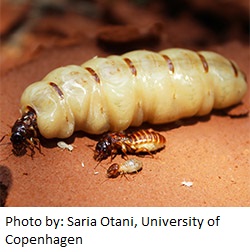 While scientists have been working for years to come up with the best ways to break down biomass for energy production, termites perfected the technique more than 30 million years ago. A new study from the University of Copenhagen and the Beijing Genomics Institute show that termites have been able to use fungus and gut bacteria contributing enzymes for final digestion.
While scientists have been working for years to come up with the best ways to break down biomass for energy production, termites perfected the technique more than 30 million years ago. A new study from the University of Copenhagen and the Beijing Genomics Institute show that termites have been able to use fungus and gut bacteria contributing enzymes for final digestion.
Fungus-farming termites are dominant plant decomposers in (sub)tropical Sub-Saharan Africa and Southeast Asia, where they in some areas decompose up to 90% of all dead plant material. They achieve near-complete plant decomposition through intricate multi-stage cooperation between the Termitomyces fungi and gut bacteria, with the termites managing these symbionts by providing gut compartments and nest infrastructure. Researchers at the Centre for Social Evolution, Department of Biology, University of Copenhagen and Beijing Genomics Institute (BGI, China) discovered this by analyzing plant decomposition genes in the first genome sequencing of a fungus-farming termite and its fungal crop, and bacterial gut communities.
“While we have so far focused on the fungus that feeds the termites, it is now clear that termite gut bacteria play a major role in giving the symbiosis its high efficiency”, says Associate Professor Michael Poulsen, who spearheaded the work.
Experts believe there could be implications for large-scale industrial bioreactors being developed today.

